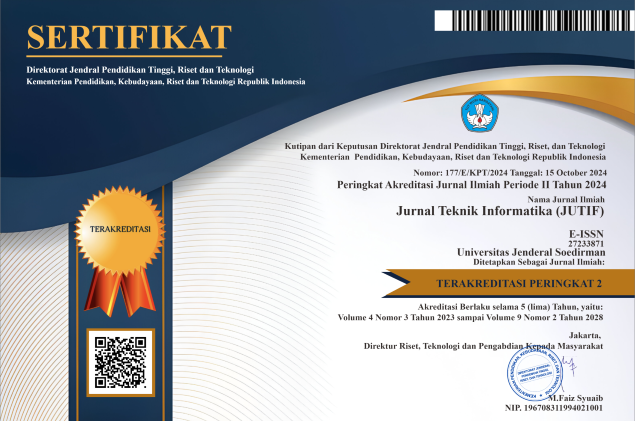SENTIMENT ANALYSIS OF INDONESIA'S CAPITAL RELOCATION USING WORD2VEC AND LONG SHORT-TERM MEMORY METHOD
DOI:
https://doi.org/10.52436/1.jutif.2025.6.1.2712Keywords:
Deep Learning, LSTM, Moving Capital, Text Classification, Word2vecAbstract
The relocation of the national capital (IKN) has garnered public attention, triggering various reactions and sentiments among the community. Sentiment analysis is crucial for understanding public perceptions of an issue, particularly on social media platforms like Twitter and YouTube. This study's sentiment analysis employs Word2Vec parameters, including architecture and dimensions. Additionally, hyperparameters such as the Optimizer and activation functions are applied to the Long Short-Term Memory (LSTM) model to analyze their effect on sentiment classification performance related to the IKN relocation. The study aims to compare the influence of Word2Vec parameters on LSTM model hyperparameter performance in sentiment classification. Data on the IKN relocation were gathered from tweets and YouTube video comments, then processed to form a text corpus used to train the Word2Vec model with Skip-gram and Continuous Bag-of-Words (CBOW) architectures, utilizing different dimension sizes (100 and 300) to enhance word representation in vectors. After obtaining word representations, the LSTM model was applied to classify sentiments using hyperparameters such as activation functions (ReLU, Sigmoid, and Tanh) and two Optimizers (Adam and RMSProp). The results indicate that the Skip-gram architecture tends to yield higher accuracy compared to CBOW, particularly with larger vector dimensions (300), which generally improved model accuracy, especially when using the RMSProp Optimizer and ReLU activation function, achieving an accuracy of 91%. It can be concluded that dimension values and architecture in Word2Vec, as well as the use of Optimizer and activation functions in LSTM, significantly impact model performance.
Downloads
References
Yasonna H. Laoly, “Presiden Republik Indonesia Peraturan Presiden Republik Indonesia,” 2020.
N. Sucahyo et al., “Analisis sentimen masyarakat terhadap uu cipta kerja pada media sosial twitter,” 2022, doi: 10.56486/jris.vol2no1.167.
A. Rahman Hakim, W. Gata, A. Zevana Putri Widodo, O. Kurniawan, and A. Rama Syarif, “Analisis Perbandingan Algoritma Machine Learning Terhadap Sentimen Analis Pemindahan Ibu Kota Negara,” Jurnal Teknologi Informasi dan Komunikasi), vol. 7, no. 2, 2023, doi: 10.35870/jti.
S. Aditua Fandhitya Silalahi, “Kajian singkat terhadap isu aktual dan strategis dampak ekonomi dan risiko pemindahan ibu kota negara,” 2019. doi: http://puslit.dpr.go.id.
Nicodemus R Toun, “Analisis Kesiapan Pemerintah Provinsi Kalimantan Tengah dalam Wacana Pemindahan Ibu Kota Negara Republik Indonesia ke Kota Palangkaraya Nicodemus R Toun,” 2018. doi: 10.36859/jap.v1i01.45.
N. S. Wardani, A. Prahutama, and P. Kartikasari, “Analisis Sentimen Pemindahan Ibu Kota Negara Dengan Klasifikasi Naïve Bayes Untuk Model Bernoulli dan Multinomial,” 2020, doi: 10.14710/j.gauss.v9i3.27963.
S. Fendyputra Pratama, R. Andrean, and A. Nugroho, “Analisis Sentimen Twitter Debat Calon Presiden Indonesia Menggunakan Metode Fined-Grained Sentiment Analysis,” JOINTECS (Journal of Information Technology and Computer Science), vol. 4, no. 2, pp. 2541–3619, 2019, doi: 10.31328/jo.
E. Sutoyo and A. Almaarif, “Twitter sentiment analysis of the relocation of Indonesia’s capital city,” Bulletin of Electrical Engineering and Informatics, vol. 9, no. 4, pp. 1620–1630, Aug. 2020, doi: 10.11591/eei.v9i4.2352.
A. Huwaidah, Adiwijaya, and S. Al Faraby, “Argument Identification in Indonesian Tweets on the Issue of Moving the Indonesian Capital,” in Procedia Computer Science, Elsevier B.V., 2021, pp. 407–415. doi: 10.1016/j.procs.2021.01.023.
C. Liu, P. Zhang, T. Li, and Y. Yan, “Semantic features based N-Best rescoring methods for automatic speech recognition,” Applied Sciences (Switzerland), vol. 9, no. 23, Dec. 2019, doi: 10.3390/app9235053.
J. (Consultant) Patterson and A. Gibson, Deep learning : a practitioner’s approach.
A. M. Bahador, “The accuracy of the LSTM model for predicting the S&P 500 index and the difference between prediction and backtesting,” 2018.
D. Shen et al., “Baseline Needs More Love: On Simple Word-Embedding-Based Models and Associated Pooling Mechanisms.”
P. F. Muhammad, R. Kusumaningrum, and A. Wibowo, “Sentiment Analysis Using Word2vec and Long Short-Term Memory (LSTM) for Indonesian Hotel Reviews,” in Procedia Computer Science, Elsevier B.V., 2021, pp. 728–735. doi: 10.1016/j.procs.2021.01.061.
S. Amin, M. Irfan Uddin, M. Ali Zeb, A. A. Alarood, M. Mahmoud, and M. H. Alkinani, “Detecting dengue/flu infections based on tweets using LSTM and word embedding,” IEEE Access, vol. 8, pp. 189054–189068, 2020, doi: 10.1109/ACCESS.2020.3031174.
D. Intan Af et al., “Pengaruh Parameter Word2Vec terhadap Performa Deep Learning pada Klasifikasi Sentimen,” vol. 6, no. 3, 2021.
H. B. Dogru, S. Tilki, A. Jamil, and A. Ali Hameed, “Deep Learning-Based Classification of News Texts Using Doc2Vec Model,” in 2021 1st International Conference on Artificial Intelligence and Data Analytics, CAIDA 2021, Institute of Electrical and Electronics Engineers Inc., Apr. 2021, pp. 91–96. doi: 10.1109/CAIDA51941.2021.9425290.
R. P. Nawangsari, R. Kusumaningrum, and A. Wibowo, “Word2vec for Indonesian sentiment analysis towards hotel reviews: An evaluation study,” in Procedia Computer Science, Elsevier B.V., 2019, pp. 360–366. doi: 10.1016/j.procs.2019.08.178.
M. I. Hutapea and A. P. Silalahi, “Moderna’s Vaccine Using the K-Nearest Neighbor (KNN) Method: An Analysis of Community Sentiment on Twitter,” Jurnal Penelitian Pendidikan IPA, vol. 9, no. 5, pp. 3808–3814, May 2023, doi: 10.29303/jppipa.v9i5.3203.
A. Kadhim, “An Evaluation of Preprocessing Techniques for Text Classification,” 2018. [Online]. Available: https://sites.google.com/site/ijcsis/
G. D’Aniello, M. Gaeta, and I. La Rocca, “KnowMIS-ABSA: an overview and a reference model for applications of sentiment analysis and aspect-based sentiment analysis,” Artif Intell Rev, vol. 55, no. 7, pp. 5543–5574, Oct. 2022, doi: 10.1007/s10462-021-10134-9.
Y. Zhu, E. Yan, and F. Wang, “Semantic relatedness and similarity of biomedical terms: Examining the effects of recency, size, and section of biomedical publications on the performance of word2vec,” BMC Med Inform Decis Mak, vol. 17, no. 1, Jul. 2017, doi: 10.1186/s12911-017-0498-1.
R. P. Nawangsari, R. Kusumaningrum, and A. Wibowo, “Word2vec for Indonesian sentiment analysis towards hotel reviews: An evaluation study,” in Procedia Computer Science, Elsevier B.V., 2019, pp. 360–366. doi: 10.1016/j.procs.2019.08.178.
S. Lai, K. Liu, L. Xu, and J. Zhao, “How to Generate a Good Word Embedding?,” Jul. 2015, [Online]. Available: http://arxiv.org/abs/1507.05523
D. Jatnika, M. A. Bijaksana, and A. A. Suryani, “Word2vec model analysis for semantic similarities in English words,” in Procedia Computer Science, Elsevier B.V., 2019, pp. 160–167. doi: 10.1016/j.procs.2019.08.153.
Y. Ardian Pradana, I. Cholissodin, and D. Kurnianingtyas, “Analisis Sentimen Pemindahan Ibu Kota Indonesia pada Media Sosial Twitter menggunakan Metode LSTM dan Word2Vec,” 2023. [Online]. Available: http://j-ptiik.ub.ac.id
Shuvayanti Das, Sohan Ghosh, and Shubham Bhattacharya, Proceedings of 2nd International Conference on Innovations in Electronics, Signal Processing and Communication - IESC 2019 : 1st-2nd March 2019. IEEE, 2019. Accessed: Sep. 15, 2024. [Online]. Available: https://ieeexplore.ieee.org/document/8902427
N. R. Ramadhanti and S. Mariyah, “Document Similarity Detection Using Indonesian Language Word2vec Model.”
C.-C. Chiu et al., “State-of-the-art Speech Recognition With Sequence-to-Sequence Models,” Dec. 2017, [Online]. Available: http://arxiv.org/abs/1712.01769
J. Cheng, L. Dong, and M. Lapata, “Long Short-Term Memory-Networks for Machine Reading,” Jan. 2016, [Online]. Available: http://arxiv.org/abs/1601.06733
M. R. Faisal and D. T. Nugrahadi, “Belajar Data Science: Klasifikasi dengan Bahasa Pemrograman R,” 2019. [Online]. Available: https://www.researchgate.net/publication/312160783


























